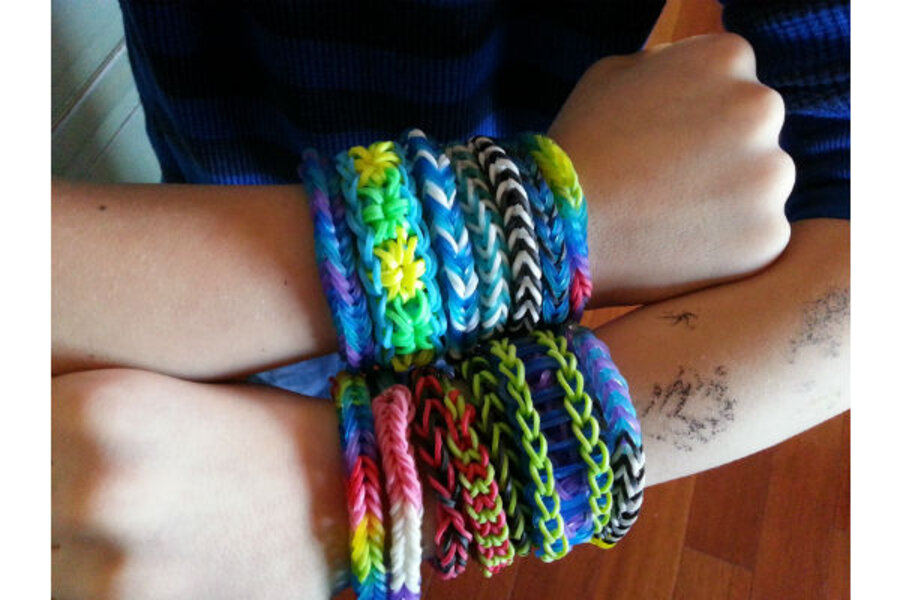Rainbow Looms: Kids crafts that parents like
Loading...
Cooper Volkman is 8 years old and full of energy. While his 10-year-old sister sits down easily to focus on projects, Cooper tends to be perpetually in motion.
Lately, though, it's been different. In the evenings, when his mom, Lori, makes dinner at home in the suburbs outside Portland, Ore., Cooper is absorbed by a new hobby: making bracelets and other objects out of tiny, colorful rubber bands.
It's the first craft project that has captured his attention. And his mother says it's helping him marshal the kind of focus and planning skills previously shown only by his big sister.
The current craze for kids — Rainbow Loom bands and their many knockoffs — has been surprising parents and child development experts since it broke out last summer and fall: In a market glutted with crafts marketed to girls, loom bands are the rare gender-neutral hobby that appeals to boys, too.
Why are they so popular?
OPEN TO EVERYONE
Tricia Ross' 8-year-old son avoids playing with any of his older sisters' toys. But he and many of his male classmates in Charlottesville, Va., have seized on loom bands.
"There's a sense of accomplishment" that comes with finishing a bracelet, Tricia Ross says, and it's enough to inspire her son to "sit there until it's complete." He's begun taking orders for bracelets from his younger sister, cranking them out in the styles and color schemes she requests.
Ross and Volkman both find that while many craft products are packaged in pink boxes emblazoned with pictures of smiling girls, the gender-neutral packaging of loom band products make them more boy-friendly. It also helps, Volkman thinks, that they use rubber bands rather than fluffy yarn or delicate materials.
GOOD FIT FOR DEVELOPMENT
Loom bands are popular among kids age 7 to 12, a key time for developing many of the skills that weaving crafts can teach.
"Right around age 7, you see fine motor skills taking off," says Cynthia Edwards, professor of psychology at Meredith College in Raleigh, N.C. "Anything that helps them to use those hands together, left and right, helps to develop those areas of the brain and the muscles themselves."
Kids in this age group are also developing "executive function," the ability to plan and execute tasks, Edwards says. With loom band weaving, kids must choose what to create (it's gone beyond bracelets to everything from backpack fobs to Minecraft-style action figures), pick a color scheme and style of weaving, gather the materials and then do the necessary weaving steps in the right order.
As work progresses, "you can see it starting to make a pattern," 8-year-old Cooper explains. "And you want to keep going until it's done."
Shauna Jones has seen her 9-year-old son, Jordan, put effort into loom bands that he doesn't put into much else. "If he can't find his loom," Jones says, "he will make them with his hands."
CREATING AND SHARING
Loom bands can be woven into just about any shape, especially with the help of step-by-step videos available at YouTube.com.
Ross says her kids search YouTube for instructions if they see a friend wearing a design they haven't tried yet. They love attempting increasingly complex designs taught in these videos, but they also like the freedom to customize them as they wish. They don't always create exactly what they set out to make, but they're usually proud of the result.
Edwards says the experience of "social comparison" is another key stage of development for kids this age: "Feeling like you can do something that's at least as good as your peers if not better than your peers," she says, leaves kids feeling competent and connected with others.
While boy crazes like Bakugan balls and Pokemon cards are about collecting and competition, many kids make loom band items to give to friends and family.
At Ross' son's school, a group of students recently sold loom bands to raise funds for an animal shelter. And, Ross says, "Our principal has them up her arms."
In Volkman's neighborhood, the school put a "moratorium" on the bracelets, she says, because entrepreneurial kids had begun selling them to classmates.
Loom bands also seem to fit kids' mobile lives: "They're portable and wearable," Edwards says, so younger kids can make them "in the backseat of a car waiting for one of their siblings to get out of ball practice."
And they don't involve a screen.
So, yes, it's a fad. And yes, parents all over the country are getting tired of finding tiny rubber bands on their floors and in their washing machines.
But few are really complaining.
"I can have a collection or I can trade them at school," says Cooper Volkman. And his mom can get dinner made with a minimum of chaos.







